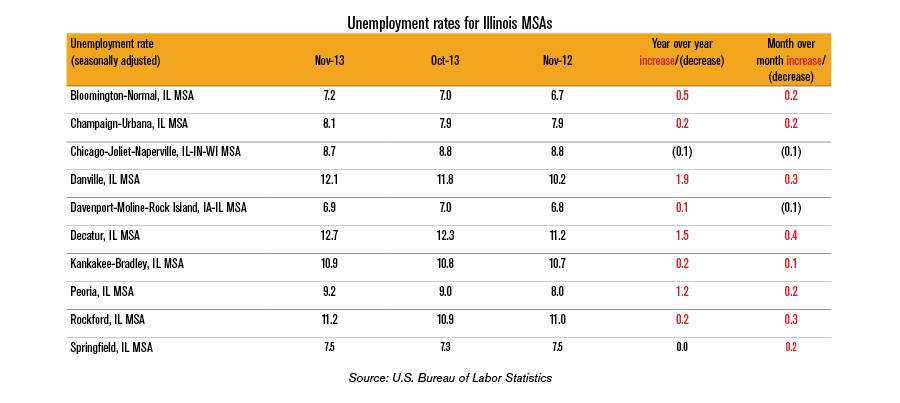Illinois metro areas still suffering from joblessness
In a repeat of last month’s disappointing employment news, eight of Illinois’ 10 Metropolitan Statistical Areas, or MSAs, saw their unemployment rates rise compared to November 2012, according to November’s metropolitan area unemployment report from the U.S. Bureau of Labor Statistics. The Decatur and Danville regions are still suffering the highest unemployment in the state,...
In a repeat of last month’s disappointing employment news, eight of Illinois’ 10 Metropolitan Statistical Areas, or MSAs, saw their unemployment rates rise compared to November 2012, according to November’s metropolitan area unemployment report from the U.S. Bureau of Labor Statistics.
The Decatur and Danville regions are still suffering the highest unemployment in the state, with 12.7 percent and 12.1 percent unemployment, respectively.
The Danville area has suffered particularly hard in 2013. Its unemployment rate is up almost two points over the year.
Chicago was the only area to experience a year-over-year decline in unemployment. The city dropped only 0.1 percentage points to 8.7 percent, two whole points above the national average of 6.7 percent.
There are still more than 423,000 people who are unemployed in the Chicago area.
Overall, metropolitan unemployment rates are 2.3 to 6.4 percentage points higher than they were in November 2007, before the recession.
Across the state, Illinoisans are still suffering from a lack of employment opportunities.
To restore true prosperity to Illinois, the state must overturn the failed policies it has been following over the past decade and embrace pro-growth and pro-job policies.
Illinois can do that by lowering its corporate income tax rate to encourage business investment, reducing onerous and costly regulations that stifle entrepreneurship, and passing labor reforms to make Illinois a more attractive businesses destination.
Enacting these polices would go a long way toward restoring jobs to Illinois’ cities and towns.

